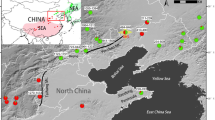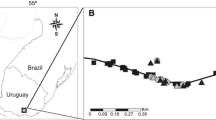Abstract
Acer mono Maxim. is one of the major components of cool temperate forests in Japan. Some of its many varieties are distributed sympatrically. Because of its great variability, the intraspecific taxonomy and nomenclature of the species are controversial. To understand the genetic relationships among these varieties and whether hybridization or introgression occurred among the sympatric varieties, we studied the genetic relationships among sympatric varieties of A. mono in the Chichibu Mountains (A. mono var. ambiguum, A. mono var. connivens, A. mono var. marmoratum) and Central Hokkaido (A. mono var. mayrii and A. mono var. glabrum) in Japan. Our results showed that varieties in Chichibu are genetically close, suggesting that hybridization or introgression might occur between these varieties, which could explain the higher genetic diversity of varieties in Chichibu than in Hokkaido. In contrast to the close relationships between the varieties in Chichibu, varieties in Hokkaido seemed relatively separated from each other; indeed, there may be reproductive isolation between the two varieties. The results provide new insight for the taxonomy of the varieties of A. mono, especially the sympatric varieties, in Japan.



Similar content being viewed by others
References
Bacck EJ, Rieseberg LH (2007) A genomic view of introgression and hybrid speciation. Curr Opin Genet Dev 17:513–518
Barluenga M, Stolting KN, Salzburger W, Muschick M, Meyer A (2006) Sympatric speciation in Nicaraguan crater lake cichlid fish. Nature 439:719–723
Cheng K, Sun K, Wen HY, Zhang M, Jia DR, Liu JQ (2009) Maternal divergence and phylogeographical relationships between Hippophae gyantsensis and H. rhamnoides subsp. Yunnanensis. J Plant Ecol (Chinese Version) 33:1–11
Dobeš CH, Mitchell-Olds T, Koch MA (2004) Extensive chloroplast haplotype variation indicates Pleistocene hybridization and radiation of North American Arabis drummondii, A. × divaricarpa, and A. holboellii (Brassicaceae). Mol Ecol 13:349–370
Fujii N, Tomaru N, Okuyama K, Koike T, Mikami T, Ueda K (2002) Chloroplast DNA phylogeography of Fagus crenata (Fagaceae) in Japan. Plant Syst Evol 232:21–33
Goudet J (2001) FSTAT, a program to estimate and test gene diversities and fixation indices (ver. 2.9.3), http://www2.unil.ch/popgen/softwares/fstat.html
Gross R, Gum B, Retter R, Kuhn R (2004) Genetic introgression between Arctic charr (Salvelinus alpinus) and brook trout (Salvelinus fontinalis) in Bavarian hatchery stocks inferred from nuclear and mitochondrial DNA markers. Aquac Int 12:19–32
Jensen RJ, Ciofani KM, Miramontes LC (2002) Lines, outlines, and landmarks: morphometric analyses of leaves of Acer rubrum, Acer saccharinum (Aceraceae) and their hybrid. Taxon, 51: 475–492. http://www.jstor.org/stable/1554860
Kikuchi S, Shibata M (2008) Development of polymorphic microsatellite markers in Acer mono Maxim. Mol Ecol Resour 8:339–341
Langella O (2002) Population 1.2.28. Logiciel de génétique des populations. Laboratoire Populations, génétique et évolution, CNRS UPR9034, Gif-sur-Yvette.,http://www.pge.cnrs-gif.fr/bioinfo/populations/index.php
Lian CL, Oishi R, Miyashita N, Nara K, Nakaya H, Wu B, Zhou Z, Hogetsu T (2003) Genetic structure and reproduction dynamics of Salix reinii during primary succession on Mount Fuji, as revealed by nuclear and chloroplast microsatellite analysis. Mol Ecol 12:609–618
Liu CP, Tsuda Y, Shen HL, Hu LJ, Saito Y, Ide Y (2014) Genetic structure and hierarchical population divergence history of Acer mono var. mono in South and Northeast China. PLoS ONE 9(1):e87187
Nei M, Tajima F, Tateno Y (1983) Accuracy of estimated phylogenetic trees from molecular data. J Mol Evol 19:153–170
Ogata K (1965) A dendrological studies on the Japanese Aceraceae, with special reference to the geographical distribution. Bull Tokyo Univ For 60:1–99
Ohashi H (1993) Nomenclature of Acer pictum Thunberg ex Murray and its Infraspecific Taxa (Aceraceae). J Jpn Bot 68:315–325
Okaura T, Harada K (2002) Phylogeographical structure revealed by chloroplast DNA variation in Japanese beech (Fagus crenata Blume). Heredity 88:322–329
Okaura T, Quang NC, Ubukata M, Harada K (2007) Phylogegraphic structure and late Quaternary population history of the Japanese oak Quercus mongolica var. crispula and related species revealed by chloroplast 16 DNA variation. Genes Genet Syst 82:465–477
Pfosser MF, Guzy-Wrobelska J, Sun BY, Stuessy TF, Sugawara T, Fujii N (2002) The origin of species of Acer (Sapindaceae) endemic to Ullung island, Korea. Syst Bot 27:351–367
Pritchard JK, Wen XQ, Falush D (2007) STRUCTURE (version 2.2). University of Chicago, Chicago, http://pritch.bsd.uchicago.edu/software
Rieseberg LH, Raymond O, Rosenthal DM, Lai Z, Livingstone K, Nakazato T, Durphy JL, Schwarzbach AE, Donovan LA, Lexer C (2003) Major ecological transitions in wild sunflowers facilitated by hybridization. Science 301:1211–1216
Saeki I, Murakami N (2009) Chloroplast DNA phylogeography of the endangered Japanese red maple (Acer pycnanthum): the spatial configuration of wetlands shapes genetic diversity. Divers Distrib 15:917–927
Satake G, Hara K, Hara H, Watari S, Tominali U (1993) Wild flowers of Japan: woody plants. Heibonsha, Tokyo
Skepner AP, Krane DE (1997) RAPD reveals genetic similarity of Acer saccharum and Acer nigrum. Heredity 80:422–428
Tanaka H, Shibata M, Masaki T, Iida S, Niiyama K, Abe S, Kominami Y, Nakashizuka T (2008) Comparative demography of three coexisting Acer species in gaps and under closed canopy. J Veg Sci 19:127–138
Terui H, Lian CL, Saito Y, Ide Y (2006) Development of microsatellite markers in Acer capillipes. Mol Ecol Notes 6:77–79
Tovar-Sánchez E, Oyama K (2004) Natural hybridization and hybrid zones between Quercus crassifolia and Quercus crassipes (Fagaceae) in Mexico: morphological and molecular evidence. Am J Bot 91:1352–1363
van Droogenbroeck B, Kyndt T, Romeijn-Peeters E, van Thuyne W, Goetghebeur P, Romero-Motochi JP, Gheysen G (2006) Evidence of natural hybridization and introgression between Vasconcellea species (Caricaceae) from southern Ecuador revealed by chloroplast, mitochondrial and nuclear DNA markers. Ann Bot 97:793–805
van Gelderen DM, de Jong PC, Oterdom HJ (1994) Maples of the world. Timber Press, Portland
Acknowledgements
We thank the staff of the University Forest in Chichibu and in Hokkaido, the University of Tokyo for their diligent fieldwork.
Author information
Authors and Affiliations
Corresponding author
Additional information
Project funding: This study was supported by National Postdoctoral Daily Fund of China and Heilongjiang Postdoctoral Fund (LBH-Z13007).
The online version is available at http://www.springerlink.com
Corresponding editor: Yu Lei
Rights and permissions
About this article
Cite this article
Liu, C., Cong, J., Shen, H. et al. Genetic relationships among sympatric varieties of Acer mono in the Chichibu Mountains and Central Hokkaido, Japan. J. For. Res. 28, 699–704 (2017). https://doi.org/10.1007/s11676-016-0352-9
Received:
Accepted:
Published:
Issue Date:
DOI: https://doi.org/10.1007/s11676-016-0352-9




